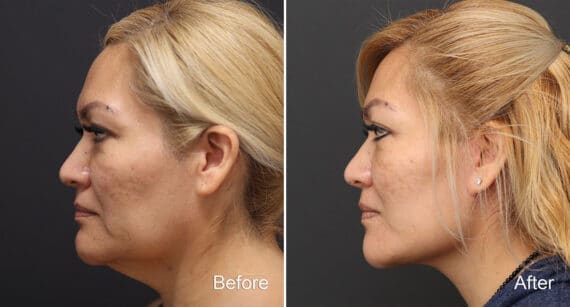Wondering if it’s too early—or too late—for a facelift? You’re not alone. Many people start to consider facial rejuvenation as soon as the first signs of aging appear, but the ideal timing, the “best age for facelift surgery,” can vary widely based on your personal goals and facial characteristics.
Whether you’re in your 40s or approaching your 60s, knowing when to take action can make all the difference. This guide breaks down what you need to know about the perfect age for a facelift and how to make the right decision for your unique journey.

At What Age Should You Get a Facelift?
The “sweet spot” for a facelift typically falls between the ages of 40 and 60, when skin laxity, volume loss, and deeper wrinkles become more prominent. However, the ideal age is not one-size-fits-all. Genetics, sun exposure, lifestyle habits, and skin quality all play a role in when someone might benefit from surgery. Some patients even opt for an earlier procedure to enjoy longer-lasting results or to address early-onset aging. Below, we explore the key variables that should shape your decision.
Factors to Consider in Facelift Surgery
Deciding on the right time for a facelift involves more than just looking at your age. A range of personal and physiological factors can influence when and whether a facelift is right for you. From the condition of your skin to your overall health and daily habits, these elements help determine the most appropriate approach for achieving lasting, natural results.
Skin Elasticity
Skin elasticity refers to how well your skin bounces back after being stretched. It plays a major role in facelift outcomes, as firmer skin adapts better to surgical repositioning and heals more smoothly. Typically, patients in their 40s or early 50s still have a good degree of elasticity, which allows for more natural-looking results. If skin has lost too much of its resilience, it may require more advanced techniques or limit the effectiveness of the facelift altogether.
Overall Health
Good overall health is essential for a safe and successful facelift procedure. Candidates should be free from serious medical conditions that could complicate surgery or healing, such as uncontrolled diabetes or cardiovascular issues. Non-smokers tend to have better outcomes, as smoking can interfere with circulation and slow recovery. Even with less invasive techniques, your body still needs to heal, so being in good physical shape helps ensure smoother results and lowers the risk of complications during and after surgery.
Patient’s Lifestyle
Your daily habits and routines can influence both the decision to get a facelift and the success of your recovery. If you have a high-stress lifestyle, frequent travel, or limited downtime, timing your procedure becomes especially important. On the other hand, those with flexible schedules may find it easier to manage the short recovery period. Long-term maintenance is another factor—those committed to healthy skincare, sun protection, and avoiding smoking typically see longer-lasting facelift results.
Individual Aging Patterns
Everyone ages differently. Genetics, lifestyle, sun exposure, and skincare routines all contribute to how and when aging signs appear. Some individuals may develop sagging skin and deep wrinkles earlier, while others maintain a youthful look well into their 60s. Recognizing your own aging timeline helps determine when a facelift will be most beneficial. By evaluating these unique patterns, a facial plastic surgeon can recommend the ideal moment for intervention, whether it’s early refinement or more advanced rejuvenation.
Facelift Patient Results


* All patients are unique and individual results may vary.
Are There Any Benefits of Getting a Facelift Earlier?
While many associate facelifts with more advanced aging, there are definite advantages to considering the procedure earlier. Patients in their 40s or early 50s often have better skin quality, quicker healing times, and more subtle signs of aging, making them excellent candidates for achieving natural-looking results. Choosing to act sooner can also mean fewer future interventions and a longer-lasting youthful appearance.
Better Recovery
One of the key benefits of getting a facelift earlier in life is faster recovery. Younger facelift patients generally heal more quickly due to better circulation and higher collagen and elastin levels in the skin. This often results in less swelling, shorter downtime, and more discreet scarring. Your body’s natural healing response is more efficient in your 40s than in later decades, allowing for a smoother post-op experience and more refined results with fewer complications.
Reduced Risks
Facelift surgery performed at a younger age typically carries fewer risks and complications. Younger patients usually have stronger immune systems, better vascular health, and more resilient skin, which means the body can tolerate surgery more effectively. There’s also less tissue damage to correct, reducing the extent of surgical intervention needed. This can lead to shorter procedures, less anesthesia time, and a lower chance of post-operative complications like prolonged swelling or infection.
More Natural Results
Undergoing a facelift earlier can lead to subtler, more natural-looking outcomes. Because facial tissues haven’t yet experienced significant sagging, the changes made during surgery are typically more refined. Rather than a dramatic transformation, patients enjoy a refreshed version of themselves—one that blends seamlessly with their natural appearance. This also allows for a more graceful aging process moving forward, as early intervention helps maintain balance and proportion as time goes on.
Wondering When to Get a Facelift?
Learn more about the ideal age for facial rejuvenation from our top-rated providers at Becker Plastic Surgery.
Are There Any Good Alternatives to a Face Lift Procedure?
Facelifts aren’t the only path to facial rejuvenation. Depending on your age, skin condition, and goals, other procedures might offer the results you’re looking for—sometimes even enhancing or delaying the need for a full facelift altogether.
Surgical alternatives and enhancements include:
- Mini Facelift – A less invasive version of the traditional facelift, ideal for patients with mild to moderate signs of aging. It targets the lower face and jawline with shorter incisions and quicker recovery.
- Neck Lift – Ideal for those whose aging is more prominent below the jawline. This procedure can tighten sagging skin and muscles in the neck for a more youthful profile.
- Fat Transfer – Adds volume to hollow areas of the face using your body’s own fat, restoring softness and contour with long-lasting results.
Non-surgical alternatives include:
- Injectables (Botox, Dermal Fillers) – Smooth fine lines, restore volume, and subtly lift features without surgery.
- Ultherapy or Radiofrequency Treatments – Use energy to stimulate collagen and tighten skin over time, great for younger patients with mild skin laxity.
- Laser Resurfacing – Improves texture and tone by treating the skin’s surface, addressing fine lines and sun damage.
A consultation with a skilled facial plastic surgeon can help you determine which combination of treatments best suits your needs and aging pattern.

Consult With an Expert Plastic Surgeon
While age can be a helpful guideline, choosing when to get a facelift is ultimately a personal decision, and one best made in consultation with a qualified plastic surgeon. A skilled provider can evaluate your skin condition, facial structure, and lifestyle to recommend the right timing and approach, whether surgical or non-surgical.
At Becker Plastic Surgery, our board-certified facial plastic surgeons specialize in both early intervention and advanced facelift techniques. With decades of combined experience, we’re committed to delivering natural, youthful results tailored to your individual needs. Visit our contact page to book a consultation or head over to our locations page to find the office nearest you—whether you’re in Philadelphia, Yardley, Princeton, Hillsborough, Voorhees, or Sewell.